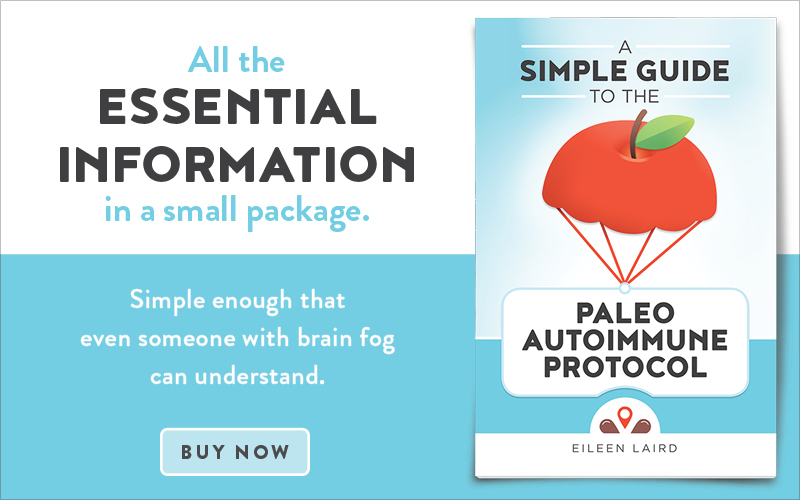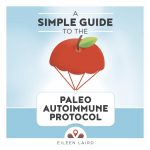
“When you trade indecision for choice, you’ll be rewarded with either success or education.”
~ Martha Beck
1. Find Your Why
Autoimmune disease often transforms a life in a frightening direction. We don’t even recognize ourselves anymore. One silver lining is that a health crisis is a powerful motivator for change. Rheumatoid arthritis hit my life like a wrecking ball in 2012, filling my body with excruciating daily pain and disabling me within just a few months. Suddenly, diet and lifestyle changes didn’t seem so hard compared to the life I was currently living. I began the paleo autoimmune protocol (AIP) in an effort to reclaim my life. I wanted less pain and more function. I wanted to be able to sleep again without pain keeping me awake. I wanted to walk across my living room without limping. I wanted to be able to shake someone’s hands with wincing. I wanted hugs to stop hurting. I wanted to laugh again instead of crying every day. That’s a powerful “why”. When faced with food temptations and the effort involved in living healthfully, I always remembered why I was doing this. Nothing tastes as good as being healthy feels, and no convenience is worth excruciating pain.
2. Educate Yourself
The AIP isn’t something you can do on the spur of the moment. You need to understand what the protocol entails to avoid making mistakes, and you need to prepare. Don’t worry – I have all the resources you need, and you don’t need months to get ready. My book, A Simple Guide to the Paleo Autoimmune Protocol, tells you everything you need to know and can be read in just a few hours. It’s simple enough that even someone with brain fog can understand, and I wrote it like a conversation between friends. I also have an AIP Series of articles on this website, including everything from an AIP grocery list to tips for doing the AIP on a budget. Lastly, my podcast airs every-other-week, providing ongoing information and inspiration for your health journey.
3. Get Support
Change is so much easier when we feel like people are on our side. Explain your “why” to your loved ones. Share my book with them, so they understand how the protocol works. Ask for their support. Not everyone understands at first, but even one person in your corner can make a big difference. And if no one in your inner circle is supportive yet, it might take seeing you improve before they realize diet and lifestyle changes really can make a difference. In the meantime, there’s an amazing AIP community worldwide. Autoimmune Wellness maintains a list of meetup groups around the world. Facebook has some wonderful peer-to-peer support groups. If you’d like some professional guidance, there is AIP group coaching available as well as 1:1 health coaches. And be sure to follow me on Instagram and Facebook. We have wonderful conversations on those pages, and it feels like a community of friends. We lift each other up and lend each other strength.
4. Hide Tempting Foods
One key to habit change is to make healthy choices easier and unhealthy ones harder. We are visual people. Simply seeing a food not allowed on the protocol can inspire a food craving and bring up feelings of deprivation. There’s a great podcast on Mind-Body Nutrition to help deal with cravings on a deeper level. But one simple tip is to put non-AIP foods out of sight, at least when you first start the protocol. If you’re lucky enough to have a household that’s willing to go AIP with you, that’s ideal, but it’s more common to share your kitchen with people following other diets. Make conscious choices about which foods get left on the counter vs. putting them behind cabinet doors. Set aside a cabinet just for you, so you don’t have to reach past those other foods when you’re hungry. Do the same in the fridge – claim a shelf and a space in the door. And for the foods that are most tempting for you, negotiate with your household to see if those can be kept out of the house. Your family or roommates can still eat those foods, just not at home. It doesn’t have to be all or nothing. There are compromises that can be made.
5. Focus on What You CAN Eat
When you first research the AIP, you find a list of foods to avoid that can be pretty overwhelming. It’s not uncommon to think, “What on earth is left to eat?” Actually, lots! If you don’t want to get stuck in a rut of the same foods on repeat, you’ll want to acquaint yourself with all the food allowed on the AIP and eat as wide a variety as possible. Food diversity is an important part of nutrient-density, and both turbocharge healing. Visit my Recipes Page for a selection of my favorite meals as well as delicious recipe collections based on theme.
6. Take Advantage of Leftovers
Going on a healing diet involves a lot of cooking. Make the most of your efforts by keeping leftovers in mind. They make quick and easy meals – whether for breakfast, lunch, or dinner the next day. They can also be portioned into mini-meals for quick snacks, or frozen for emergency meals later. You can double recipes or simply choose ones that already make 6-10 servings. You can also try batch cooking – this is where you spend a few hours once or twice a week and cook all your food for the week. At the beginning of the week, sit down and figure out where you have some open time to cook, and where leftovers would be a lifesaver. Resources: Saving Time in the Kitchen Podcast and AIP Meal Prep Cookbook.
7. Have Healthy Snacks Available
AIP snacks aren’t available at your local convenience store, and you don’t want to find yourself hungry with nothing to eat. That means you need to create convenience for yourself in advance. Come up with a list of healthy snacks for easy reference. Always carry something with you, and also have options available at home. For a snack to be satiating, it should contain protein or healthy fats – ideally both. So, mini-meals are actually perfect. (See tip #6 above). Other great ideas are an avocado (one of my favorites), coconut chips, canned seafood, and AIP protein bars. If you want a piece of fruit, pair it with some protein (like leftover chicken or liver pate) or a healthy fat (like coconut butter or tigernut butter). Eating fruit by itself can send your blood sugar on a rollercoaster and leave you feeling hungrier and crankier.
8. Go Light on the Desserts
The paleo autoimmune protocol isn’t a diet of deprivation, so I’m not going to say you can never have a cookie. In fact, having some AIP-friendly desserts in the freezer can help keep you motivated and prevent you from reaching for the candy bars of your past. That was definitely true for me. However, it’s very easy to overdo! Just because a recipe is AIP doesn’t meant it’s automatically healthy. It just means it doesn’t contain any forbidden ingredients. The healthiest recipes are the ones that are made from the simplest ingredients: quality meat, seafood, vegetables, and healthy fats. Once you start adding flours and sugars (even natural AIP-friendly ones), you’re moving into the realm of treats. Even natural sugars are inflammatory if you eat too much. Resource: Where Do Natural Sugars Fit on a Healing Diet?
9. Remember: It’s About More Than Just Food
While the diet is the most famous aspect of the paleo autoimmune protocol, it’s just one piece and it doesn’t work alone. Lifestyle factors like sleep, stress management, and emotional support all have major impacts on autoimmune health. For many people, they’re bigger flare triggers than food. Keep that in mind as you go forward. It can be overwhelming to try to change everything all it once, so it’s fine to take it in pieces. You can start with food and when that becomes routine, start to address lifestyle. Or start by prioritizing sleep, which can give you more energy and willpower for making dietary changes. Or begin with stress management, which helps us feel more capable of achieving our goals. They’re all interconnected. For resources, check out my lifestyle and mindset pages for articles, podcasts, and tutorials. I also wrote a book called Healing Mindset. It’s a guide to the mind-body connection for people with autoimmune disease.
10. Track Your Progress
It’s human nature to focus on what’s wrong more than what’s right. In fact, we sometimes forget symptoms once they disappear and are no longer claiming our attention. This can leave us feeling like no progress is being made. Before you start the AIP, begin with a baseline. Mark all of your current symptoms down – physical, mental, and emotional. Then track how you feel each day, and at the end of a month, see if anything’s changed. Often change comes in baby steps, too. Writing things down makes the slow improvements more clear. Resource: How to Keep a Symptom Journal.
*Bonus Tip: Strict AIP Isn’t Meant to Last Forever
The AIP starts with the elimination phase, but it doesn’t end there. Reintroductions are part of the process, and eventually you personalize the diet for you. The elimination phase is important – it removes the most common inflammatory foods, allowing the immune system to calm down, your gut to heal, and your health to improve. That gives you a baseline for testing foods during reintroductions. This second phase is where you learn to communicate with your body and discover which foods you can successfully add back into your diet and which foods are best avoided, at least for now. The goal isn’t the strictest diet possible, but rather the widest diet that supports your autoimmune health. However, the reintroduction process is tricky and easy to do incorrectly. Don’t worry – I have resources to help. Read this article for a quick overview of the reintroduction process. My e-book, Reintroducing Foods on the AIP, is a step-by-step guide with recipes. I also have an interview series, where people share their own reintroduction journeys: the foods they do and don’t tolerate, and how they learned to tell the difference.
You May Also Be Interested In









